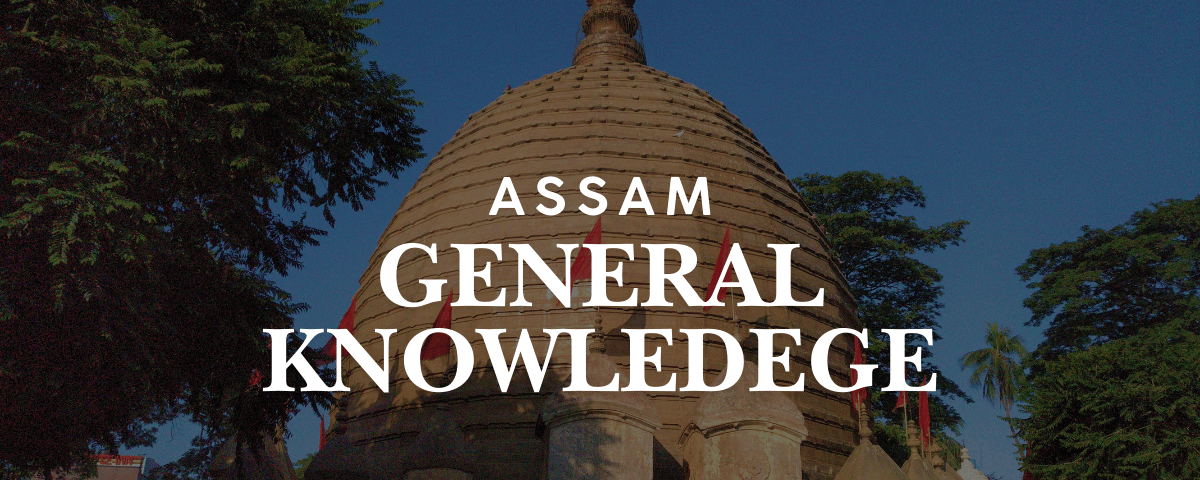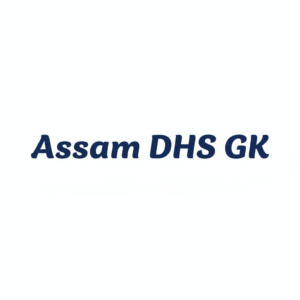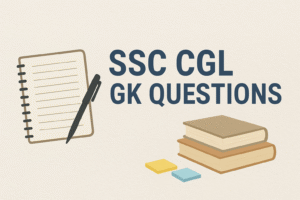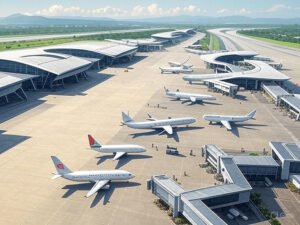History of Assam for Competitive Exams
Master the History of Assam for Competitive Exams with this collection of 100 MCQs, tailored for APSC, UPSC, and state-level aspirants. From ancient Kamarupa to the Ahom dynasty, colonial struggles, and the transformative Assam Movement, these questions cover Assam’s rich past. Grab these free MCQs to excel in your exams and deepen your understanding of Assam’s heritage
Ancient and Medieval History: History of Assam for Competitive Exams
- India’s first tsunami early warning center was established in:
A) Guwahati
B) Shillong
C) New Delhi
D) Chennai
Answer: A) Guwahati - The famous satriya dance form was founded by:
A) Bhupen Hazarika
B) Sankardev
C) Lakshminath Bezbaruah
D) Bishnu Prasad Rabha
Answer: B) Sankardev - The first Assamese novel “Miri Jiyori” was written by:
A) Lakshminath Bezbaruah
B) Rajanikanta Bordoloi
C) Jyoti Prasad Agarwala
D) Indira Goswami
Answer: B) Rajanikanta Bordoloi - The “Boro Chuk” is related to which type of Assamese architecture?
A) Fort
B) Temple
C) Palace
D) Stone Bridge
Answer: C) Palace - The “Rangman” was the mascot of which event hosted by Assam?
A) National Games 2007
B) Asian Games 1982
C) National Film Festival 2005
D) International Tea Festival 2013
Answer: A) National Games 2007 - The “Jayanta Baruah” was a leader associated with which organization?
A) Assam Association
B) Jorhat Sarbajanik Sabha
C) Axomiya Bhasa Unnati Sadhini Sabha
D) Assam Provincial Congress Committee
Answer: B) Jorhat Sarbajanik Sabha - The “Kareng Ghar” was commissioned around the middle of which century?
A) 16th century
B) 17th century
C) 18th century
D) 19th century
Answer: C) 18th century - The famous Buranji chronicler S.K. Bhuyan belonged to which century?
A) 17th
B) 18th
C) 19th
D) 20th
Answer: D) 20th - Which Assamese king is credited with founding the Salastambha dynasty in this History of Assam for Competitive Exams MCQ?
A) Pushyavarman
B) Salastambha
C) Bhaskarvarman
D) Narayanvarman
Answer: B) Salastambha - The “Treaty of Asurar Ali” was signed between the Ahoms and which group?
A) Mughals
B) Burmese
C) Koch
D) British
Answer: A) Mughals
Ahom Dynasty – Administration: History of Assam for Competitive Exams
- The “Sarbananda Singha” was the chief of which group?
A) Tai-Ahoms
B) Mataks
C) Morans
D) Chutias
Answer: B) Mataks - The “Rajkhowa” in the Ahom Paik system was in charge of how many paiks?
A) 20
B) 100
C) 300
D) 6000
Answer: C) 300 - Which river was defined as the boundary between the Ahom and Mungkang (Burmese) kingdoms in 1401?
A) Patkai
B) Dhansiri
C) Brahmaputra
D) Kopili
Answer: A) Patkai - Who was the first Ahom king to adopt the Hindu title “Maharaja”?
A) Gadadhar Singha
B) Sudangpha (Bamuni Konwar)
C) Pratap Singha
D) Sukaphaa
Answer: B) Sudangpha (Bamuni Konwar) - The Ahom post “Barbaruah” was introduced during whose reign?
A) Suhungmung
B) Pratap Singha
C) Rudra Singha
D) Gadadhar Singha
Answer: B) Pratap Singha - Who was the ruler of the Kamata Kingdom when the Ahoms married the Kamata princess?
A) Pratapdhwaj
B) Naranarayan
C) Chilarai
D) Satrudaman
Answer: A) Pratapdhwaj
Ahom Dynasty – Conflicts: History of Assam for Competitive Exams
- Which Ahom king is credited with defeating the Kachari king in 1531?
A) Suhungmung
B) Suklenmung
C) Pratap Singha
D) Susenpha
Answer: A) Suhungmung - The Battle of Dhubri in 1648 was fought against which force?
A) Mughals
B) Koch
C) Burmese
D) British
Answer: A) Mughals - Who led the Ahom forces in the Battle of Ghilajharighat in 1663?
A) Lachit Borphukan
B) Jayadhwaj Singha
C) Chakradhwaj Singha
D) Atan Burhagohain
Answer: C) Chakradhwaj Singha - The Treaty of Majuli in 1563 ended hostilities with which kingdom?
A) Koch
B) Kachari
C) Chutia
D) Mughal
Answer: B) Kachari - Which Ahom king faced the Burmese invasion led by Alaungpaya in 1751?
A) Rajeswar Singha
B) Siva Singha
C) Pramatta Singha
D) Lakshmi Singha
Answer: A) Rajeswar Singha
Cultural Contributions: History of Assam for Competitive Exams
- The “Jyoti Chitraban” film studio was opened in which city of Assam?
A) Dibrugarh
B) Guwahati
C) Jorhat
D) Silchar
Answer: B) Guwahati - The oldest Assamese literary organization is:
A) Assam Sahitya Sabha
B) Jorhat Sarbajanik Sabha
C) Assam Association
D) Axomiya Bhasa Unnati Sadhini Sabha
Answer: D) Axomiya Bhasa Unnati Sadhini Sabha - The instrument called “Pepa” is traditionally associated with which Assamese community?
A) Bodo
B) Karbi
C) Mishing
D) Tiwa
Answer: A) Bodo - The “Hastividyarnava” is a book on:
A) Irrigation techniques
B) Study of elephants
C) Ancient warfare
D) Religious rituals
Answer: B) Study of elephants - What is the primary language of the Ahom Buranjis?
A) Assamese
B) Tai-Ahom
C) Sanskrit
D) Bengali
Answer: B) Tai-Ahom - The “Dadara” is associated with:
A) A form of folk dance
B) An Ahom military post
C) A battle site during Ahom-Mughal wars
D) None of the above
Answer: A) A form of folk dance
Colonial Period: History of Assam for Competitive Exams
- The city of Tezpur is famous for which archaeological site?
A) Ambari
B) Da Parbatia
C) Madan Kamdev
D) Suryapahar
Answer: B) Da Parbatia - The “Assam Tea Auction Centre” was established in Guwahati in which year?
A) 1960
B) 1970
C) 1975
D) 1980
Answer: B) 1970 - The “Silsako” is historically related to:
A) Battle site
B) Bridge in Guwahati
C) Tower of victory
D) Market place
Answer: B) Bridge in Guwahati - The first Assamese film “Joymoti” was produced and directed by:
A) Bhupen Hazarika
B) Jyoti Prasad Agarwala
C) Rohini Baruah
D) Maniram Dewan
Answer: B) Jyoti Prasad Agarwala - The “Phulaguri Dhawa” unrest occurred in which ethnic community’s region?
A) Tiwa
B) Bodo
C) Karbi
D) Mising
Answer: A) Tiwa - The first Assamese movie to receive the President’s Medal is:
A) Joymoti
B) Piyoli Phukan
C) Indramalati
D) Monomoti
Answer: B) Piyoli Phukan
Modern History: History of Assam for Competitive Exams
- The first woman Chief Minister of Assam was:
A) Anwara Taimur
B) Syeda Anwara Taimur
C) Hemoprova Saikia
D) Tarun Gogoi
Answer: B) Syeda Anwara Taimur - The famous “Dipankar Bhattacharjee” is known for which sport?
A) Football
B) Table Tennis
C) Hockey
D) Badminton
Answer: B) Table Tennis - The “Bodoland Territorial Council” (BTC) was established in which year?
A) 1990
B) 2000
C) 2002
D) 2005
Answer: C) 2002 - The Guwahati Planetarium was established in:
A) 1980
B) 1990
C) 1994
D) 2000
Answer: C) 1994 - The Assam Valley Literary Award was first given in which year?
A) 1980
B) 1990
C) 2000
D) 2010
Answer: B) 1990 - The “Ashok Paper Mill” was founded in which Assamese town?
A) Jogighopa
B) Dibrugarh
C) Guwahati
D) Jorhat
Answer: A) Jogighopa
Assam Movement: History of Assam for Competitive Exams
- The Assam Movement was sparked by concerns over what issue in this History of Assam for Competitive Exams MCQ?
A) Land reforms
B) Illegal immigration
C) Economic disparity
D) Language policy
Answer: B) Illegal immigration - Who was a key leader of the All Assam Students’ Union during the Assam Movement?
A) Prafulla Kumar Mahanta
B) Gopinath Bordoloi
C) Tarun Gogoi
D) Bishnuram Medhi
Answer: A) Prafulla Kumar Mahanta - The Nellie Massacre, a tragic event during the Assam Movement, occurred in which year?
A) 1980
B) 1983
C) 1985
D) 1987
Answer: B) 1983
Cultural Festivals: History of Assam for Competitive Exams
- The “Nagaon” district is famous for which annual event?
A) Bihu Dance Festival
B) Boat Race
C) Magh Bihu Feast
D) Jatra (folk performance)
Answer: A) Bihu Dance Festival - The first Assamese newspaper “Batori” was published from:
A) Guwahati
B) Jorhat
C) Dibrugarh
D) Sivasagar
Answer: B) Jorhat - The name “Assam” is believed to be an anglicization of:
A) Ahom
B) Asom
C) Kamrupa
D) Pragjyotisha
Answer: B) Asom - The “Jorhat Sarbajanik Sabha” was founded in:
A) 1884
B) 1903
C) 1921
D) 1937
Answer: A) 1884 - The first satellite launched related to Northeast India was called:
A) INSAT
B) Microsat-R
C) GSAT
D) RISAT
Answer: B) Microsat-R
Freedom Movement: History of Assam for Competitive Exams
- Who founded the Assam Provincial Congress Committee in 1921?
A) Kuladhar Chaliha
B) Tarun Ram Phukan
C) Nabin Chandra Bordoloi
D) Ambikagiri Raychoudhury
Answer: B) Tarun Ram Phukan - Which Assamese leader was exiled to Rangoon for anti-British activities?
A) Maniram Dewan
B) Piyoli Barua
C) Kushal Konwar
D) Anandaram Dhekial Phukan
Answer: C) Kushal Konwar - The Assam Students’ Conference was first held in which year?
A) 1916
B) 1920
C) 1926
D) 1930
Answer: A) 1916
miscellaneous: History of Assam for Competitive Exams
- Which ancient kingdom was known as Pragjyotishpura in the Mahabharata?
A) Kamarupa
B) Koch
C) Chutia
D) Ahom
Answer: A) Kamarupa - Who was the first Varman king to establish diplomatic ties with China?
A) Bhaskarvarman
B) Pushyavarman
C) Samudravarman
D) Naraka
Answer: A) Bhaskarvarman - The Salastambha dynasty succeeded which kingdom in Assam?
A) Varman
B) Pala
C) Koch
D) Ahom
Answer: A) Varman - Which Ahom king introduced the coinage system known as “Octa”?
A) Sukaphaa
B) Suhungmung
C) Pratap Singha
D) Rudra Singha
Answer: B) Suhungmung - The Ahom title “Swargadeo” was first used by which king?
A) Sukaphaa
B) Suhungmung
C) Susenpha
D) Pratap Singha
Answer: B) Suhungmung - Which Ahom king built the Joysagar Temple in Sivasagar?
A) Rudra Singha
B) Siva Singha
C) Rajeswar Singha
D) Lakshmi Singha
Answer: A) Rudra Singha - The Battle of Hadira Choki in 1657 was fought against which Mughal general?
A) Mir Jumla
B) Aurangzeb
C) Ram Singh
D) Turbak Khan
Answer: A) Mir Jumla - Which Koch king is credited with building the Gohain Kamal Ali road?
A) Biswa Singha
B) Naranarayan
C) Chilarai
D) Lakshminarayan
Answer: B) Naranarayan - The Chutia kingdom’s capital was located at which modern-day site?
A) Sadiya
B) Guwahati
C) Tezpur
D) Jorhat
Answer: A) Sadiya - Which Assamese saint composed the “Borgeet” devotional songs?
A) Sankardev
B) Madhabdev
C) Both A and B
D) Damodardev
Answer: C) Both A and B - The “Namghar” is a community prayer hall associated with which movement?
A) Shaktism
B) Vaishnavism
C) Buddhism
D) Shaivism
Answer: B) Vaishnavism - The “Ankiya Nat” plays were introduced by whom?
A) Sankardev
B) Madhabdev
C) Lakshminath Bezbaruah
D) Bhupen Hazarika
Answer: A) Sankardev - The first British Resident of Assam after the Treaty of Yandaboo was:
A) David Scott
B) Francis Jenkins
C) Thomas Anstey
D) John Butler
Answer: A) David Scott - The Assam Land and Revenue Regulation was enacted in which year?
A) 1828
B) 1833
C) 1845
D) 1861
Answer: B) 1833 - Who was the first Assamese to pass the Indian Civil Service exam?
A) Anandaram Dhekial Phukan
B) Hemchandra Barua
C) Anundoram Borooah
D) Lakshminath Bezbaruah
Answer: C) Anundoram Borooah - The first tea garden in Assam was established at:
A) Chabua
B) Jorhat
C) Dibrugarh
D) Tinsukia
Answer: A) Chabua - Which British official discovered tea in Assam in 1823?
A) Robert Bruce
B) David Scott
C) Charles Alexander Bruce
D) Francis Jenkins
Answer: A) Robert Bruce - The Assam Oil Company was founded in which year?
A) 1889
B) 1899
C) 1909
D) 1919
Answer: A) 1889 - The first modern cotton mill in Assam was established at:
A) Guwahati
B) Dibrugarh
C) Tezpur
D) Nagaon
Answer: B) Dibrugarh - The Dhola-Sadiya Bridge was inaugurated in which year?
A) 2015
B) 2017
C) 2019
D) 2021
Answer: B) 2017 - Which Assamese leader was known as the “Lion of Assam”?
A) Kushal Konwar
B) Tarun Ram Phukan
C) Ambikagiri Raychoudhury
D) Bishnuram Medhi
Answer: C) Ambikagiri Raychoudhury - The first Assamese woman to participate in the Non-Cooperation Movement was:
A) Chandraprabha Saikiani
B) Kanaklata Barua
C) Pushpalata Das
D) Phuleshwari
Answer: A) Chandraprabha Saikiani - The Assam Accord was monitored by which central government ministry?
A) Home Ministry
B) External Affairs
C) Education Ministry
D) Finance Ministry
Answer: A) Home Ministry - Which Assamese leader became India’s fifth President?
A) Gopinath Bordoloi
B) Fakhruddin Ali Ahmed
C) Bimala Prasad Chaliha
D) Tarun Gogoi
Answer: B) Fakhruddin Ali Ahmed - The “Ali-Aye-Ligang” festival is celebrated by which community?
A) Bodo
B) Mising
C) Karbi
D) Dimasa
Answer: B) Mising - The Jonbeel Mela is associated with which community?
A) Tiwa
B) Rabha
C) Mising
D) Deori
Answer: A) Tiwa - The “Bohagiyo Bishu” festival is celebrated by which tribe?
A) Deori
B) Mising
C) Karbi
D) Dimasa
Answer: A) Deori - The traditional Assamese rice beer used in Bihu celebrations is called:
A) Xaj
B) Apong
C) Lao Pani
D) Sulai
Answer: A) Xaj - The traditional Assamese silk saree “Mekhela Chador” is made using which weaving technique?
A) Powerloom
B) Handloom
C) Backstrap
D) Machine
Answer: B) Handloom - The “Orunodoi” magazine, Assam’s first periodical, was published in:
A) 1846
B) 1856
C) 1866
D) 1876
Answer: A) 1846 - Who is known as the “Sahitya Kandari” of Assam?
A) Lakshminath Bezbaruah
B) Hemchandra Barua
C) Anandaram Dhekial Phukan
D) Hiren Bhattacharyya
Answer: C) Anandaram Dhekial Phukan - The Assamese novel “Mamare Dhara Tarowal” was written by:
A) Indira Goswami
B) Lakshminath Bezbaruah
C) Homen Borgohain
D) Bhabendra Nath Saikia
Answer: A) Indira Goswami - The “Assamiya Sahitar Buranji” was published in:
A) 1905
B) 1912
C) 1920
D) 1930
Answer: B) 1912 - Which river, apart from the Brahmaputra, is significant in Assamese history?
A) Dikhow River
B) Subansiri River
C) Kolong River
D) Dhansiri River
Answer: A) Dikhow River - The Assam Legislative Assembly was first established in:
A) 1937
B) 1947
C) 1952
D) 1960
Answer: A) 1937 - The Barak Valley is primarily inhabited by which community?
A) Assamese
B) Bengali speakers
C) Bodos
D) Karbis
Answer: B) Bengali speakers - Which Assamese leader was known as “Kalaguru”?
A) Bhupen Hazarika
B) Bishnu Prasad Rabha
C) Lakshminath Bezbaruah
D) Homen Borgohain
Answer: B) Bishnu Prasad Rabha - The first railway line in Assam connected which two places?
A) Guwahati and Jorhat
B) Dibrugarh and Margherita
C) Guwahati and Tezpur
D) Jorhat and Sibsagar
Answer: B) Dibrugarh and Margherita - Which Assamese film director won the National Film Award for “Halodhia Choraye Baodhan Khai”?
A) Jahnu Barua
B) Bhabendra Nath Saikia
C) Bhupen Hazarika
D) Zubeen Garg
Answer: A) Jahnu Barua - The “Bhaona” is a traditional Assamese performance associated with:
A) Vaishnavism
B) Shaktism
C) Buddhism
D) Shaivism
Answer: A) Vaishnavism - Which Ahom king shifted the capital to Jorhat in 1794?
A) Gaurinath Singha
B) Kamaleshwar Singha
C) Chandrakanta Singha
D) Purandar Singha
Answer: A) Gaurinath Singha - The “Patharughat Uprising” was a response to what British policy?
A) Land revenue increase
B) Tea taxation
C) Forced labor
D) Education reforms
Answer: A) Land revenue increase - Which Assamese poet is known as the “Father of Assamese Literature”?
A) Lakshminath Bezbaruah
B) Hemchandra Barua
C) Madhab Kandali
D) Ananta Kandali
Answer: A) Lakshminath Bezbaruah - The “Kaziranga National Park” was declared a UNESCO World Heritage Site in which year?
A) 1985
B) 1990
C) 1995
D) 2000
Answer: A) 1985 - Which Ahom queen rebuilt the Kamakhya Temple in 1565?
A) Phuleshwari
B) Ambika
C) Kuranganayani
D) Jaymati
Answer: C) Kuranganayani - The “Dehing Patkai Festival” celebrates which aspect of Assam’s heritage?
A) Wildlife conservation
B) Tea industry
C) Tribal culture
D) River navigation
Answer: A) Wildlife conservation - Which Assamese freedom fighter was martyred during the Quit India Movement?
A) Kanaklata Barua
B) Kushal Konwar
C) Chandraprabha Saikiani
D) Maniram Dewan
Answer: A) Kanaklata Barua - The “Manas National Park” is famous for which endangered species?
A) One-horned rhinoceros
B) Bengal tiger
C) Pygmy hog
D) Asian elephant
Answer: C) Pygmy hog - Which Ahom king introduced the “Buranji” chronicle system?
A) Sukaphaa
B) Suhungmung
C) Pratap Singha
D) Rudra Singha
Answer: B) Suhungmung - The “Ambubachi Mela” is held annually at which temple?
A) Kamakhya Temple
B) Umananda Temple
C) Hayagriva Madhava Temple
D) Dirgheshwari Temple
Answer: A) Kamakhya Temple
Supercharge your APSC and UPSC preparation with these 100 MCQs on the History of Assam for Competitive Exams. Covering ancient kingdoms, Ahom valor, cultural heritage, and the Assam Movement, this collection is your ultimate tool to master Assam’s past. Seize these free MCQs now and triumph in your exams
Other Parts of Assam History MCQs
100 Assam History MCQs for Competitive Exams Part 1
100 Assam History MCQs for Competitive Exams Part 2
100 Assam History MCQs for competitive Exams Part 3





